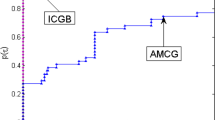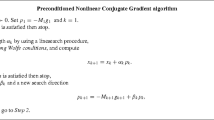Abstract
The goal of this paper is to make a trial for evaluating the computational efficiency of the conjugate gradient method and to discuss some practical aspects important for the user in solving large and sparse systems of linear equations arising from the discretization of boundary value problems for elliptic partial differential equations. The solution efficiency of different algorithms of the conjugate gradient method is investigated by comparison with the computational work of the solution obtained from the standard method SLOR (1-line SOR).
Comparisons are made with the same initial guess and stopping criterion in numerical experiments on test examples representative for nuclear engineering problems. Advantages in improving the rate of convergence in the SLOR method resulting from the use of compensating initial guesses are demonstrated also.
Similar content being viewed by others
References
L.A. Hageman and D.M. Young, Applied iterative methods. Academic Press, N.Y., 1981.
Z.I. Woźnicki, AGA two-sweep iterative method and their application for the solution of linear equation systems. Proc. International Conference in Linear Algebra and Applications, Valencia, Spain, Sept. 28–30, 1987 (Linear Algebra Appl.,121 (1989), 702–710).
Z.I. Woźnicki, Nonnegative splitting theory. To appear in Japan J. Indust. Appl. Math.
M.R. Hestenes and E. Stiefel, Methods of conjugate gradients for solving linear systems. J. Res. Nat. Bur. Standards,49 (1952), 409–436.
J.K. Reid, On the method of conjugate gradient for the solution of large sparse systems of linear equations. Proc. Conference on Large Sparse Systems of Linear Equations, Academic Press, NY, 1971, 231–254.
P. Concus, G.H. Golub and D.P. O’Leary, Generalized conjugate gradient method for the solution of ellitic partial differential equations. Sparse Matrix Computations (eds. J.R. Bunch and D.J. Rose), Academic Press, NY, 1976, 309–332.
D.S. Kershaw, The incomplete Cholesky—Conjugate gradient method for the iterative solution of systems of linear equations. J. Comput. Phys.,26 (1978), 43–65.
A. Meijerink and H. Van der Vorst, An iterative solution method for linear systems of which the coefficient matrix is a symmetricM-matrix. Math. Comp.,31 (1977), 148–162.
A. Meijerink and H. Van der Vorst, Guidelines for usage of incomplete decompositions in solving sets of linear equations as they occur in practical problems. J. Comput. Phys.,44 (1981), 134–155.
A. Greenbaum, Comparison of splittings used with the conjugate gradient algorithm. Numer. Math.,33 (1979), 181–194.
P. Concus, G.H. Golub and G. Meurant, Block preconditioning for the conjugate gradient method. SIAM J. Sci. Statist. Comput.,6 (1985), 230–252.
S. Eisenstat, Efficient implementation of a class of preconditioned conjugate gradient method. SIAM J. Sci. Statist. Comput.,2 (1981), 1–4.
Author information
Authors and Affiliations
Additional information
The previous version of this paper appeared in Proc. Copper Mountain Conference on Iterative Methods, Copper Mountain, Colorado, USA, April 1992.
About this article
Cite this article
Woźnicki, Z.I. On numerical analysis of conjugate gradient method. Japan J. Indust. Appl. Math. 10, 487–519 (1993). https://doi.org/10.1007/BF03167286
Received:
Revised:
Issue Date:
DOI: https://doi.org/10.1007/BF03167286




